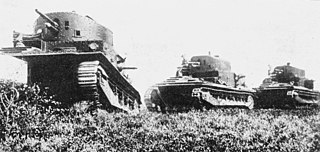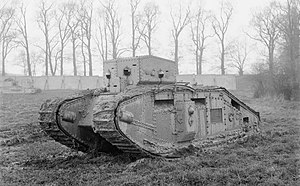History
The engineer Lieutenant Walter Wilson and the industrialist Sir William Tritton had cooperated in 1915 to develop the Mark I, the world's first operational tank. However, when Tritton decided to build the Medium Mark A "Whippet", Wilson was left out. The Medium A was designed by Tritton's chief engineer, William Rigby. The Whippet was a successful design and proved effective but suffered from a lack of power, complex steering and unsprung suspension. Wilson, now a Major, decided he could by himself develop a better tank as replacement: the 'Medium Tank Mark B'. He probably started drawing in July 1917. Major Philip Johnson of Central Tank Workshops was impressed when he was shown a wooden mock-up during a visit to Britain late 1917. The prototype was built by Tritton's firm, the Metropolitan Carriage and Wagon Company, and was finished in September 1918.
It seems that early in the design process Wilson considered building an alternative or parallel Male version fitted with a 2-pounder (~40 mm gun) in the superstructure but he had abandoned these plans by March 1918.
The design by Wilson had elements of both the Mark I and the Whippet: a similar but smaller tracked rhomboid chassis of the former and fixed turret like the latter. A novel feature was the separate compartment in the back, housing the 100 hp (75 kW) engine (a four-cylinder shortened Ricardo design) and behind it the epicyclic transmission. Two fuel tanks at the back held 85 imperial gallons (386 L) of petrol. Other innovations were the ability to lay a smoke screen and the use of sloped armour in the front of the hull. The smoke screen device consisted of a sulphonic acid reservoir located over the exhaust pipe. [2] Armament consisted of a maximum of five machine guns in the superstructure and two in the side doors. These hull doors looked a bit like miniature sponsons. The machine guns were removable and in practice fewer guns would have been taken along, the machine-gunner moving his gun when switching position; most sources give an estimate of four.
A production of 450 vehicles had been ordered even before the prototype was finished and this number was now increased to 700, to be manufactured at North British Locomotive in Glasgow and later at Metropolitan, Coventry Ordnance Works and the Patent Shaft and Axletree Company. Confusingly the new tank was to have the same name as the Mark A: "Whippet". Almost immediately after having been taken into use, the type fell from grace for two reasons. Firstly the engine compartment couldn't be easily accessed from the fighting compartment. Repair under fire would therefore have been very dangerous. Secondly Tritton had constructed a rival type: the Medium Mark C "Hornet". This other design had superior speed and trench crossing abilities. Wilson had limited the size of the Mark B to that of a single railway flatcar. The end of the war led to cancellation after 102 were produced out of the first order for 450. [1] Of these only 45 were taken into service by the British Army, the remaining 57 probably going straight to the scrapyard. [1]
After the war the type was quickly phased out in favour of the Mark C. Two vehicles were used by the North Russian Tank Detachment. Both were lost and the Red Army used at least one until the Thirties. The last British unit to have the Mark B in service was 17th (Armoured Car) Battalion during the Anglo-Irish War.

The Infantry Tank Mark II, better known as the Matilda, is a British infantry tank of the Second World War.

The Sturmpanzerwagen A7V was a heavy tank introduced by Germany in 1918 during World War I. One hundred chassis were ordered in early 1917, ten to be finished as fighting vehicles with armoured bodies, and the remainder as Überlandwagen cargo carriers. The number to be armoured was later increased to 20. They were used in action from March to October 1918, and were the only tanks produced by Germany in World War I to be used in combat, as well as being the first operational German Tank. It was developed as a response to British tanks. Although the A7V is generally considered to be better designed compared to its counterparts, it struggled to procure high production numbers due to its relative complexity and high cost.

The Tank, Cruiser, Mk II (A10), was a cruiser tank developed alongside the A9 cruiser tank, and was intended to be a heavier, infantry tank version of that type. In practice, it was not deemed suitable for the infantry tank role and was classified as a "heavy cruiser". It served briefly in World War II.

The Medium Mark A Whippet was a medium tank employed by the British in World War I. Intended for fast mobile assaults, it was intended to complement the slower British heavy tanks by using its relative mobility and speed in exploiting any break in the enemy lines.

The Medium Mark C Hornet was a British medium tank developed during the First World War, but produced too late to see any fighting.

The Mark VI was a British heavy tank project from the First World War.

The Flying Elephant was a proposed super-heavy tank, planned but never built by the British during World War I.

The development of tanks in World War I was a response to the stalemate that developed on the Western Front. Although vehicles that incorporated the basic principles of the tank had been projected in the decade or so before the War, it was the alarmingly heavy casualties of the start of its trench warfare that stimulated development. Research took place in both Great Britain and France, with Germany only belatedly following the Allies' lead.

The BTR-40 is a Soviet open-topped, wheeled armoured personnel carrier and reconnaissance vehicle. It is often referred to as the Sorokovka in Soviet service. It was eventually replaced in the APC role by the BTR-152 and in the scout car role by the BRDM-1.

The Vickers Medium Mark II was a British tank built by Vickers in the Inter-war period.

The Vickers Medium Mark I was a British tank of the Inter-war period built by Vickers from 1924.

Little Willie was a prototype in the development of the British Mark I tank. Constructed in the autumn of 1915 at the behest of the Landship Committee, it was the first completed tank prototype in history. Little Willie is the oldest surviving individual tank, and is preserved as one of the most famous pieces in the collection of The Tank Museum, Bovington, England.
The Char G1 was a French replacement project for the Char D2 medium tank. Several prototypes from different companies were developed from 1936 onwards, but not a single one had been fully completed at the time of the Fall of France in 1940. The projects represented some of the most advanced French tank design of the period and finally envisaged a type that would have been roughly equal in armament and mobility to later World War II standard tanks of other nations, such as the Soviet T-34 and the American M4 Sherman, but possessing several novel features, such as gun stabilisation, a semi-automatic loader and an optical rangefinder.

The Imperial Japanese Army (IJA) initially purchased foreign tanks for evaluation during World War I, and began developing its own indigenous designs during the late 1920s.

The British Mark V tank was an upgraded version of the Mark IV tank.

The Type 5 medium tank Chi-Ri was a medium tank developed by the Imperial Japanese Army in World War II. It was intended to be a heavier, more powerful version of Japan's prototype Type 4 Chi-To medium tank. Only one incomplete prototype was built.

The Medium Mark III was a medium tank developed by the United Kingdom during the Interwar period.

The Uralmash-1 (Уралмаш-1) was a Soviet prototype self-propelled gun developed during World War II. It was a turretless, tracked armoured fighting vehicle designed by the Yekaterinburg-based Uralmash design bureau (UZTM) between autumn 1944 and spring 1945. It used the chassis of the T-44 medium tank and was intended to replace the SU-100 which itself had only entered service with the Red Army in late 1944. Two prototypes of the Uralmash-1 with different armament were built in early 1945, one with the 100 mm D-10 tank gun, the other with the 122 mm D-25S tank gun. While mass production was initially recommended, the end of the war with Germany in May 1945 eventually caused the project to be cancelled due to lack of necessity. If the Uralmash-1 had entered service, the 100 mm variant would have been designated SU-101 (СУ-101) while the 122 mm variant would have been designated SU-102 (СУ-102), in accordance with Soviet military nomenclature, where the "SU"-label stood for Samokhodnaya Ustanovka, or self-propelled gun.

This article on military tanks deals with the history and development of tanks of the British Army from their first use in the First World War, the interwar period, during the Second World War, the Cold War and modern era.

Medium Mark D was a British medium tank developed at the end of the First World War.
This page is based on this
Wikipedia article Text is available under the
CC BY-SA 4.0 license; additional terms may apply.
Images, videos and audio are available under their respective licenses.



















